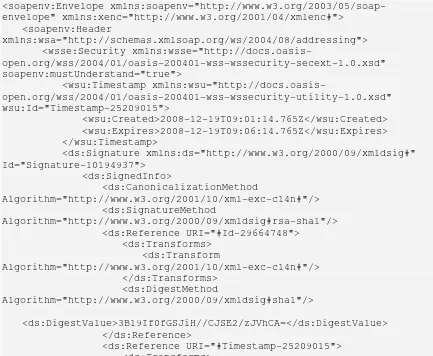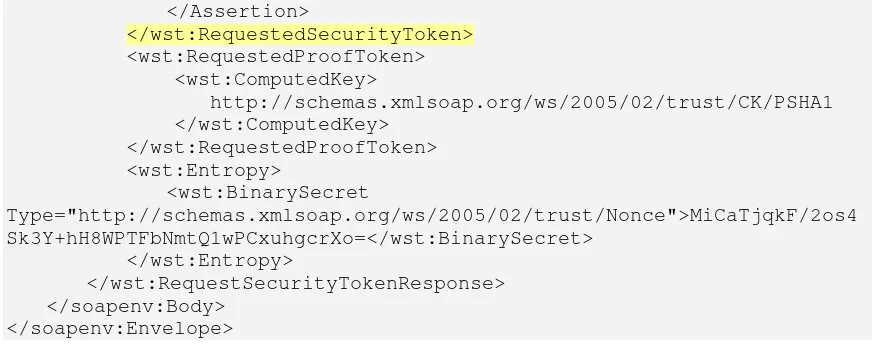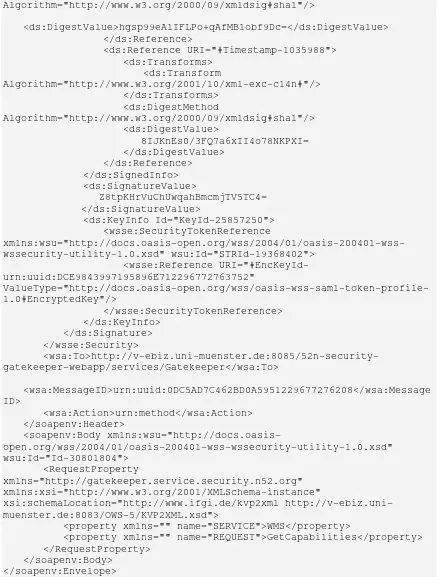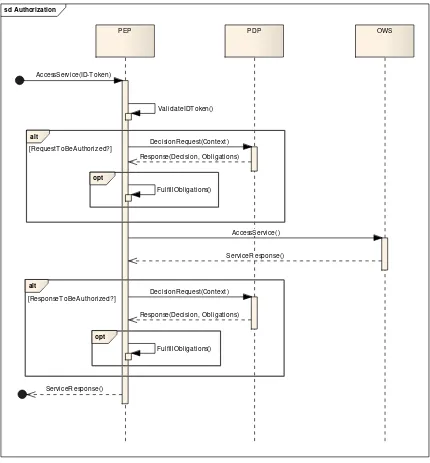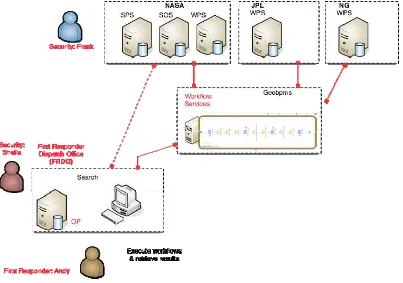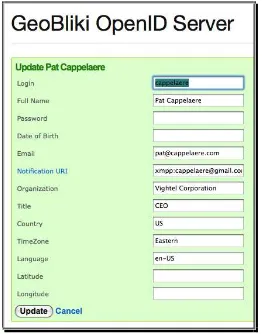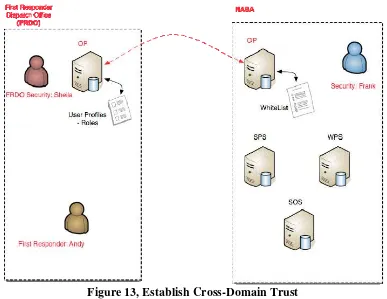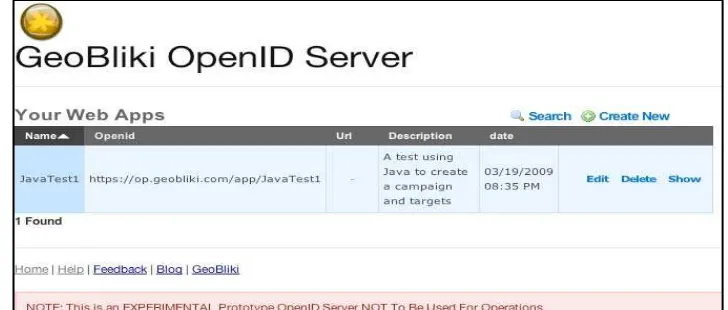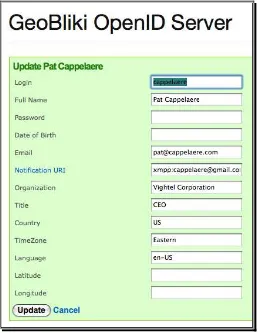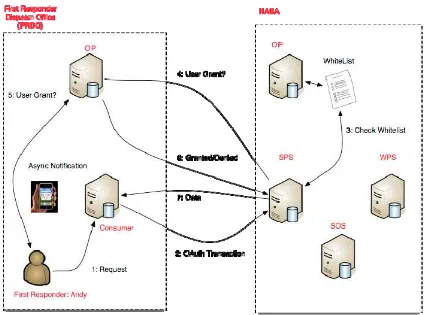Open Geospatial Consortium Inc.
Date:2009-10-09
Reference number of this document:OGC 09-035
Version:0.3.0
Category: OGC® Public Engineering Report
Editor(s):Rüdiger Gartmann, Lewis Leinenweber
OGC
®OWS-6 Security Engineering Report
Copyright © 2009Open Geospatial Consortium, Inc.
To obtain additional rights of use, visit http://www.opengeospatial.org/legal/.
Warning
This document is not an OGC Standard. This document is an OGC Public
Engineering Report created as a deliverable in an OGC Interoperability Initiative and is not an official position of the OGC membership. It is distributed for review and comment. It is subject to change without notice and may not be referred to as an OGC Standard. Further, any OGC Engineering Report should not be referenced as required or mandatory technology in procurements.
Document type: OpenGIS® Engineering Report Document subtype: NA
License Agreement
Permission is hereby granted by the Open Geospatial Consortium, ("Licensor"), free of charge and subject to the terms set forth below, to any person obtaining a copy of this Intellectual Property and any associated documentation, to deal in the Intellectual Property without restriction (except as set forth below), including without limitation the rights to implement, use, copy, modify, merge, publish, distribute, and/or sublicense copies of the Intellectual Property, and to permit persons to whom the Intellectual Property is furnished to do so, provided that all copyright notices on the intellectual property are retained intact and that each person to whom the Intellectual Property is furnished agrees to the terms of this Agreement.
If you modify the Intellectual Property, all copies of the modified Intellectual Property must include, in addition to the above copyright notice, a notice that the Intellectual Property includes modifications that have not been approved or adopted by LICENSOR.
THIS LICENSE IS A COPYRIGHT LICENSE ONLY, AND DOES NOT CONVEY ANY RIGHTS UNDER ANY PATENTS THAT MAY BE IN FORCE ANYWHERE IN THE WORLD.
THE INTELLECTUAL PROPERTY IS PROVIDED "AS IS", WITHOUT WARRANTY OF ANY KIND, EXPRESS OR IMPLIED, INCLUDING BUT NOT LIMITED TO THE WARRANTIES OF MERCHANTABILITY, FITNESS FOR A PARTICULAR PURPOSE, AND NONINFRINGEMENT OF THIRD PARTY RIGHTS. THE COPYRIGHT HOLDER OR HOLDERS INCLUDED IN THIS NOTICE DO NOT WARRANT THAT THE FUNCTIONS CONTAINED IN THE INTELLECTUAL PROPERTY WILL MEET YOUR REQUIREMENTS OR THAT THE OPERATION OF THE INTELLECTUAL PROPERTY WILL BE UNINTERRUPTED OR ERROR FREE. ANY USE OF THE INTELLECTUAL PROPERTY SHALL BE MADE ENTIRELY AT THE USER’S OWN RISK. IN NO EVENT SHALL THE COPYRIGHT HOLDER OR ANY CONTRIBUTOR OF INTELLECTUAL PROPERTY RIGHTS TO THE INTELLECTUAL PROPERTY BE LIABLE FOR ANY CLAIM, OR ANY DIRECT, SPECIAL, INDIRECT OR CONSEQUENTIAL DAMAGES, OR ANY DAMAGES WHATSOEVER RESULTING FROM ANY ALLEGED INFRINGEMENT OR ANY LOSS OF USE, DATA OR PROFITS, WHETHER IN AN ACTION OF CONTRACT, NEGLIGENCE OR UNDER ANY OTHER LEGAL THEORY, ARISING OUT OF OR IN CONNECTION WITH THE IMPLEMENTATION, USE, COMMERCIALIZATION OR PERFORMANCE OF THIS INTELLECTUAL PROPERTY.
This license is effective until terminated. You may terminate it at any time by destroying the Intellectual Property together with all copies in any form. The license will also terminate if you fail to comply with any term or condition of this Agreement. Except as provided in the following sentence, no such termination of this license shall require the termination of any third party end-user sublicense to the Intellectual Property which is in force as of the date of notice of such termination. In addition, should the Intellectual Property, or the operation of the Intellectual Property, infringe, or in LICENSOR’s sole opinion be likely to infringe, any patent, copyright, trademark or other right of a third party, you agree that LICENSOR, in its sole discretion, may terminate this license without any compensation or liability to you, your licensees or any other party. You agree upon termination of any kind to destroy or cause to be destroyed the Intellectual Property together with all copies in any form, whether held by you or by any third party.
Except as contained in this notice, the name of LICENSOR or of any other holder of a copyright in all or part of the Intellectual Property shall not be used in advertising or otherwise to promote the sale, use or other dealings in this Intellectual Property without prior written authorization of LICENSOR or such copyright holder. LICENSOR is and shall at all times be the sole entity that may authorize you or any third party to use certification marks, trademarks or other special designations to indicate compliance with any LICENSOR standards or specifications.
This Agreement is governed by the laws of the Commonwealth of Massachusetts. The application to this Agreement of the United Nations Convention on Contracts for the International Sale of Goods is hereby expressly excluded. In the event any provision of this Agreement shall be deemed unenforceable, void or invalid, such provision shall be modified so as to make it valid and enforceable, and as so modified the entire Agreement shall remain in full force and effect. No decision, action or inaction by LICENSOR shall be construed to be a waiver of any rights or remedies available to it.
Preface
This Engineering Report describes work accomplished to investigate and implement security for OGC web services during the OGC Web Services Testbed, Phase 6 (OWS-6).
Suggested additions, changes, and comments on this draft report are welcome and encouraged. Such suggestions may be submitted by email message or by making suggested changes in an edited copy of this document.
The changes made in this document version, relative to the previous version, are tracked by Microsoft Word, and can be viewed if desired. If you choose to submit suggested changes by editing this document, please first accept all the current changes, and then make your suggested changes with change tracking on.
Attention is drawn to the possibility that some of the elements of this document may be the subject of patent rights. The Open Geospatial Consortium Inc. shall not be held responsible for identifying any or all such patent rights.
OWS-6 Testbed
OWS testbeds are part of OGC's Interoperability Program, a global, hands-on and
collaborative prototyping program designed to rapidly develop, test and deliver Engineering Reports and Change Requests into the OGC Specification Program, where they are
formalized for public release. In OGC's Interoperability Initiatives, international teams of technology providers work together to solve specific geoprocessing interoperability problems posed by the Initiative's sponsoring organizations. OGC Interoperability Initiatives include test beds, pilot projects, interoperability experiments and interoperability support services - all designed to encourage rapid development, testing, validation and adoption of OGC standards.
In April 2008, the OGC issued a call for sponsors for an OGC Web Services, Phase 6 (OWS-6) Testbed activity. The activity completed in June 2009. There is a series of on-line
demonstrations available here: http://www.opengeospatial.org/pub/www/ows6/index.html The OWS-6 sponsors are organizations seeking open standards for their interoperability requirements. After analyzing their requirements, the OGC Interoperability Team
recommended to the sponsors that the content of the OWS-6 initiative be organized around the following threads:
1. Sensor Web Enablement (SWE)
2. Geo Processing Workflow (GPW)
3. Aeronautical Information Management (AIM)
4. Decision Support Services (DSS)
5. Compliance Testing (CITE)
The OWS-6 sponsoring organizations were:
• U.S. National Geospatial-Intelligence Agency (NGA)
• Joint Program Executive Office for Chemical and Biological Defense (JPEO-CBD)
• GeoConnections - Natural Resources Canada
• U.S. Federal Aviation Agency (FAA)
• EUROCONTROL
• EADS Defence and Communications Systems
• US Geological Survey
• BAE Systems
• ERDAS, Inc.
The OWS-6 participating organizations were:
52North, AM Consult, Carbon Project, Charles Roswell, Compusult, con terra,
Contents
Page1 Introduction ...1
1.1 Scope ...1
1.2 Document contributor contact points ...2
1.3 Revision history ...2
1.4 Future work ...2
2 References ...2
3 Terms and definitions ...4
3.1 Security domain ...4
3.2 Authentication ...5
3.3 Authorization ...5
3.4 Non-repudiation ...5
3.5 Proxy ...5
3.6 Trust ...5
4 Conventions ...5
4.1 Abbreviated terms ...5
5 Security Overview ...6
6 Security Requirements ...6
6.1 Confidentiality ...6
6.2 Authenticity ...7
6.3 Integrity ...7
6.4 Non-Repudiation ...7
6.5 Access Control ...8
6.6 Audit/Auditing ...8
7 Cryptography ...8
7.1 Symmetric Cryptography ...8
7.2 Asymmetric Cryptography ...8
7.2.1 Encryption ...9
7.2.2 Digital Signatures...9
8 Trust ...9
8.1 Introduction ...9
8.2 Public Key Infrastructure (PKI) Concept ...10
8.3 Trust Establishment ...11
8.3.1 Direct Trust ...11
8.3.2 Direct Brokered Trust ...11
8.3.3 Indirect Brokered Trust ...12
9 Abstract Security Architecture ...12
9.1 Security Extensions to Existing OGC Architecture ...12
9.3 Dynamic View: Security Workflows ...14
10 SOAP Binding ...15
10.1 Relevant Standards ...15
10.2 Protocol ...16
10.3 Interactions ...16
10.3.1 Binding to a Secured Service ...16
10.3.2 Authorization ...30
11 RESTful Security for OGC Web Services ...32
11.1 Bindings ...33
11.2 Relevant Standards & Specifications ...33
11.3 Standards and Protocols ...33
11.4 Interactions ...38
11.4.1 Register User with OpenID ...39
11.4.2 Establish Trust ...39
11.4.3 Registering Application with OpenID ...42
11.4.4 Creating a Certificate Authority (CA) ...42
11.4.5 Create a Certificate Request ...43
11.4.6 Extract Public and Private Keys ...44
11.4.7 Create a Web Application Entry on the OpenID Server ...44
11.4.8 Cross-Domain Authority Delegation ...46
11.4.9 Application Consumer OAuth request ...47
11.4.10 GeoBPMS Data Provider (SPS) Response ...48
11.4.11 Target Service Request to Service Provider ...50
12 XACML Policy Models ...50
12.1 XACML Policy Language Model ...51
12.2 XACML Data Flow Policy Model ...52
12.3 Obligations ...54
12.4 Spatial Authorization ...54
12.4.1 GeoXACML ...55
12.4.1.1 GeoXACML’s Geometry Model and Spatial Functions ...55
12.4.1.2 Summary of GeoXACML’s Capabilities ...56
12.4.2 XACML with Spatial Obligations ...56
12.4.2.1 WMS Example ...57
12.4.2.2 WFS Example ...62
13 OWS-6 Use Cases ...73
13.1 OWS-6 WS-Security Deployment ...73
13.2 Within One Security Domain ...75
13.3 Between Trusted Security Domains ...75
13.4 Between Un-trusted Security Domains (Trust Establishment) ...78
13.5 Between Un-trusted Security Domains (Forwarding) ...79
14 RFQ Use Cases ...80
14.1 Within One Security Domain ...81
14.2 Between Trusted Security Domains ...83
15 Future Work and Unsolved Issues ...86
15.1 Security Metadata ...87
15.1.1 Technical Metadata ...87
15.1.2 Content Metadata ...87
15.1.3 Capabilities ...88
15.2 Security Error Messages ...88
15.3 Blocking or Filtering ...89
15.4 Standardization of Obligations ...89
15.5 Architecture of the Access Control System ...90
15.6 Altering Results ...90
15.7 Performance ...90
15.8 OGC Service Types ...91
Figures
Page Figure 1, Abstract Security Components ... 13Figure 2, Abstract Security Interactions ... 15
Figure 3, Binding to a Secured Service ... 17
Figure 4, Example GetMetadata Request ... 17
Figure 5, Example WS-MetadataExchange Response ... 18
Figure 6, Example WS-Policy description ... 20
Figure 7, Example RequestSecurityToken request ... 22
Figure 8, Example RequestSecurityToken response ... 26
Figure 9, GetCapabilities SOAP request with SAML holder-of-key assertion and signature (Example) ... 29
Figure 10, Authorization Process ... 31
Figure 11, RESTful Workflow and Security Deployment ... 32
Figure 12, OpenID Server User Profile Entry/Update ... 39
Figure 13, Establish Cross-Domain Trust ... 40
Figure 14, Create a new Web Application Entry on the OpenID Server ... 45
Figure 15, OpenID Application Consumer Key ... 45
Figure 16, OpenID Server Interface to enter User’s Identity Profile ... 46
Figure 17, Delegation of Authority using OAuth and OpenID ... 47
Figure 18, XACML Language Policy Model... 51
Figure 19, XACML v1.0 Data Flow Model ... 53
Figure 20, Policy for WMS with Spatial Obligations ... 60
Figure 22, Restricted GetMap Response ... 62
Figure 23, WFS GetFeature Request submitted to PEP ... 66
Figure 24, PDP Authorization Decision Request ... 67
Figure 25, PolicySet used for authorization decision ... 71
Figure 26, Authorization Decision Response with Obligation (OGC Filter) ... 72
Figure 27, WFS GetFeature Request with Filter Encoding ... 73
Figure 28: Basic Security Deployment ... 74
Figure 29: Actual OWS-6 Deployment ... 75
Figure 30: Security between Trusted Security Domains ... 76
Figure 31: Interactions between Trusted Domains ... 76
Figure 32: Trusted Domains, alternative 1 ... 77
Figure 33: Trusted Domains, alternative 2 ... 78
Figure 34: Trust Establishment between Non-Trusted Domains... 79
OGC
®OWS-6 Security Engineering Report
1 Introduction
1.1 Scope
This Engineering Report describes work accomplished during the OGC Web Services Testbed, Phase 6 (OWS-6) to investigate and implement security measures for OGC web services. This work was undertaken to address requirements stated in the OWS-6
RFQ/CFP originating from a number of sponsors, from OGC staff, and from OGC members.
The tasks undertaken to satisfy these requirements provided results related to three different approaches:
• Web services security using XACML policies with spatial obligations and related software implementations;
• Web services security using GeoXACML policies and related software implementations; and
• RESTful web services security using OpenID / OAuth and related software implementations.
Each approach and its solution provided opportunities to experiment with existing security specifications and standards to demonstrate applicability, interoperability and to identify potential implementation and standards issues where future work may be
required.
1.2 Document contributor contact points
All questions regarding this document should be directed to the editor or the contributors:
Name Organization
Rüdiger Gartmann con terra GmbH
Lewis Leinenweber BAE Systems
Jan Hermann Technische Universität München
Pat Cappeleare Vightel
1.3 Revision history
Date Release Editor Primary clauses modified
Description
2008/11/17 0.0.1 RG All Document initialized
2009/04/01 0.0.2 RG 12 Policy encoding
2009/04/03 0.0.3 RG 15 Unsolved issues
2009/06/15 0.0.4 LEL 4,7,8,10, 13 General edits; added RFQ Use Cases 2009/06/18 0.0.5 LEL Various Minor edits
2009/06/19 0.0.6 LEL Various Minor edits
2009/07/15 0.0.7 LEL 11 Added RESTful security; added reference material for GeoXACML and ER 2009/07/17 0.0.8 LEL Various Overall document edits and update 2009/08/03 0.0.9 RG Various Several edits
2009/08/12 0.0.10 LEL Various Minor edits
2009/10/08 0.3.0 Carl Reed Various Ready document for posting as Public ER
1.4 Future work
Improvements in this document are desirable to address open issues; to correct errors or enhance existing document content.
See also section 15 for a description of web service security-related issues arising during this testbed and for topics to be considered for future testbeds.
2 References
The following documents are referenced in this document. For dated references, subsequent amendments to, or revisions of, any of these publications do not apply. For undated references, the latest edition of the normative document referred to applies. As this document is not an implementation specification, there are no normative
references. However, the following documents are considered to be relevant to this report and useful for the reader.
[3] OGC 06-107r1, OWS-4 Trusted GeoServices IPR
[4] OGC 04-095, OpenGIS Filter Encoding Implementation Specification, Version 1.1
[5] OGC 07-158, Wrapping OGC HTTP-GET/POST Services with SOAP, OGC Discussion Paper.
[6] Common Criteria, http://www.niap-ccevs.org/cc-scheme/cc_docs/
[7] eXtensible Access Control Markup Language (XACML) Version 2.0, OASIS Standard, 1 Feb 2005, http://docs.oasis-open.org/xacml/2.0/access_control-xacml-2.0-core-spec-os.pdf
[8] eXtensible Access Control Markup Language (XACML) Version 1.1, OASIS Committee Draft, 7 August 2003,
http://www.oasis-open.org/committees/xacml/repository/cs-xacml-specification-1.1.pdf
[9] Core and hierarchical role based access control (RBAC) profile of XACML v2.0. RBAC profile. OASIS Standard. 01 February 2005.
http://docs.oasis-open.org/xacml/2.0/access_control-xacml-2.0-rbac-profile1-spec-os.pdf
[10] eXtensible Access Control Markup Language (XACML) Version 1.0, OASIS Standard, 18 February 2003,
http://www.oasis-open.org/committees/download.php/2406/oasis-xacml-1.0.pdf
[11] OGC 04-095, OpenGIS® Filter Encoding Implementation Specification
[12] Security Assertion Markup Language (SAML) V2.0, OASIS Standard, 15 March 2005, http://docs.oasis-open.org/security/saml/v2.0/saml-2.0-os.zip
[13] Web service Description Language (WSDL) v2.0, http://www.w3.org/TR/2007/REC-wsdl20-20070626/
[14] Web Services Addressing (WS-Addressing), W3C Member Submission, 10 August 2004, http://www.w3.org/Submission/2004/SUBM-ws-addressing-20040810/
[15] Web Services Metadata Exchange, W3C Member Submission, 13 August 2008, http://www.w3.org/Submission/2008/SUBM-WS-MetadataExchange-20080813/
[16] Web Services Policy 1.2 - Framework (WS-Policy), W3C Member Submission, 25 April 2006,
http://www.w3.org/Submission/2006/SUBM-WS-Policy-20060425/
http://www.oasis- open.org/committees/download.php/16790/wss-v1.1-spec-os-SOAPMessageSecurity.pdf
[18] WS-SecurityPolicy 1.2, OASIS Standard, 1 July 2007, http://docs.oasis-open.org/ws-sx/ws-securitypolicy/200702/ws-securitypolicy-1.2-spec-os.pdf
[19] WS-Trust 1.3, OASIS Standard, 19 March 2007, http://docs.oasis-open.org/ws-sx/ws-trust/200512/ws-trust-1.3-os.pdf
[20] XML Encryption Syntax and Processing, W3C Recommendation, 10 December 2002, http://www.w3.org/TR/2002/REC-xmlenc-core-20021210/
[21] XML Signature Syntax and Processing (Second Edition), W3C Recommendation, 10 June 2008, http://www.w3.org/TR/2008/REC-xmldsig-core-20080610/
[22] OpenID Authentication 2.0 – Final, http://openid.net/specs/openid-authentication-2_0.html
[23] OpenID Attribute Exchange 1.0 – Final, http://openid.net/specs/openid-attribute-exchange-1_0.html
[24] OpenID Simple Registration Extension 1.0, http://openid.net/specs/openid-simple-registration-extension-1_0.html
[25] OAuth Core 1.0 Specification, http://oauth.net/core/1.0/
[26] NIST Guide to Secure Web Services, SP800-95, August 2007, http://csrc.nist.gov/publications/nistpubs/800-95/SP800-95.pdf
[27] Guide for the Security Certification and Accreditation of Federal Information Systems, NIST 800-37
NOTE This OWS Common Specification contains a list of normative references that are also applicable to this Implementation Specification.
3 Terms and definitions
For the purposes of this Engineering Report, the definitions specified in Clause 4 of the OWS Common Implementation Standard [OGC 06-121r3] shall apply. In addition, the following terms and definitions apply.
3.1 Security domain
3.2 Authentication
Verification that a potential partner in a conversation is capable of representing a person or organization.
3.3 Authorization
Determination whether a subject is allowed to have the specified types of access to particular resource.
3.4 Non-repudiation
Assurance that the sender of information is provided with proof of delivery and the recipient is provided with proof of the sender’s identity, so neither can later deny having processed the information.
3.5 Proxy
An agent that acts on behalf of a requester to relay a message between a requester agent and a provider agent. The proxy appears to the provider agent Web service to be the requester.
3.6 Trust
The characteristic that one entity is willing to rely upon a second entity to execute a set of actions and/or to make set of assertions about a set of subjects and/or scopes.
4 Conventions
4.1 Abbreviated terms
Most of the abbreviated terms listed in Subclause 5.1 of the OWS Common
Implementation Standard [OGC 05-008] apply to this document, plus the following abbreviated terms.
CA Certificate Authority
GeoPDP Geospatially-enabled Policy Decision Point
GeoXACML Geospatial eXtensible Access Control Markup Language
GPW GeoProcessing Workflow
IC-ISM Intelligence Community Metadata Standard for Information Security Marking
PAP Policy Administration Point
PDP Policy Decision Point
PKI Public Key Infrastructure
SAML Security Assertion Markup Language SOAP Simple Object Access Protocol
STS Security Token Service
XACML eXtensible Access Control Markup Language
5 Security Overview
Security has several aspects, which have to be addressed separately. OWS-6 is focused on access control, which may require security features such as confidentiality, integrity, authenticity and non-repudiation of the service communication
Not all security features are required in every use case. Moreover, security requirements have to be evaluated and security measures have to be derived individually. Thus, a security framework defines a toolbox, providing a set of security mechanisms, all of them fulfilling different security requirements. After deciding on the required level of security, a system’s designer is then able to select those security features needed in a certain use case.
This testbed did not attempt to define any concrete set of security requirements or attack scenarios but examined one approach to the use of the technologies.
6 Security Requirements
Security requirements differ for different applications. Thus, an actual security solution always has to match the individual security requirements. This section discusses the most relevant security requirements within OWS-6 and beyond, being relevant for securing OGC Web services. These requirements only address message exchange, which is relevant when defining Web service interfaces and protocols. There may be other
requirements addressing physical or organizational protection as well as the protection of data, but this is out of scope for this document.
6.1 Confidentiality
Providing confidentiality means protecting messages against unauthorized reading. It has to be ensured that only the designated communication partners (typically the sender and the receiver of a message) can access the content of a message.
6.2 Authenticity
Authenticity provides evidence for for the actual origin of the communication message with the authenticated party. A variety of methods and standards that may be used to provide authentication for OGC web services as shown below:
• HTTP Authentication
• Session Management / Cookies
• SAML
• Shibboleth
• OpenID
• WS-Security
For authentication a variety of different mechanisms exist. Typically, authenticity can be guaranteed on message level by applying digital signatures to messages. These signatures are validated against the public key of the sender, and thus valid signatures can only be generated by the owner of the corresponding private key. Therefore, if a signature can be validated against a certain public key, the owner of this key pair has to be the originator of this signature.
On transport level, authenticity can be provided by requiring an adequate certificate during the handshake of the secure connection, which is derived by a trusted root certificate. Once this connection is established, authenticity is provided for all messages being submitted by the communication partner who provided this certificate (sender and/or receiver).
In OWS-6, development and demonstrations were focused on use of WS-Security, SAML and OpenID.
6.3 Integrity
Integrity protects messages against unnoticed modifications. Typically, integrity is provided by the use of digital signatures. These signatures are tightly bound to the message to be protected. Whenever there was a modification of this message after the signature was applied, a validation of this signature will fail.
If security on transport level is provided, integrity is ensured once the secure communication session is established.
6.4 Non-Repudiation
Non-repudiation provides evidence for the existence of this message. Non-repudiation is ensured by storing messages together with a valid signature of the sender. If a sender denies having submitted a certain message afterwards, the receiver can expose the signed message. Since nobody but the sender would be able to generate this signature, this stored message proves that the message was signed by the holder of the public key
6.5 Access Control
Access control is not directly related to message exchange, but nevertheless it is one of the key requirements within OWS-6. Access control aims at authorizing service requests. For access controlled services incoming requests are matched against policies which define access rights to certain resources for certain subjects (requestors). If these access rights cover the requested action, access is permitted, otherwise access will be denied.
6.6 Audit/Auditing
A family of security controls in the technical class dealing with ensuring activity involving access to and modification of sensitive or critical files is logged, monitored, and possible security violations investigated. [27].
7 Cryptography
Cryptography is a key technology to meet the security requirements described in section 6. This section briefly discusses cryptographic methods used for encrypting and signing messages.
7.1 Symmetric Cryptography
Symmetric cryptography is sometimes called "secret-key cryptography" (versus public-key cryptography) because the entities that share the public-key, such as the originator and the recipient of a message, need to keep the key secret. Keeping the shared key secret entails both cost and risk when the key is distributed. Thus, symmetric cryptography has a key management disadvantage compared to asymmetric cryptography1.
Since asymmetric cryptographic algorithms for encryption tend to be computationally intensive, WS-SecureConversation specification was developed. This specification allows use of faster symmetric algorithms for message-level security, making it well-suited for OGC web services and clients where large volumes of messages may be exchanged between many clients and a few data or service providers.2
7.2 Asymmetric Cryptography
Asymmetric cryptography (also known as Public Key Cryptography) uses a pair of keys for any participant of a secure communication. One key has to be kept secret (private key), while the other key is public (public key) and has to be shared with the
communication partners.
The basic principle of asymmetric cryptography is that cipher text encrypted with one key of this pair can only be decrypted with the other one. If a message is encrypted with a public key it can only be decrypted with the corresponding private key and vice versa. This characteristic can be used for encrypting and signing messages, as shown in the following examples.
Typically, asymmetric cryptography is used for the initialization of a communication and for exchange of a session key, which then is used to continue the communication via symmetric cryptography due to its better performance.
7.2.1 Encryption
User A wants to send an encrypted message to user B. User A encrypts the message with B’s public key using a asymmetric cryptography, so only B is able to decrypt this
message with his own private key.
Since asymmetric cryptography needs far more computation than symmetric encryption, both technologies are typically used in combination. First, the initiator of the
communication creates a session key which is asymmetrically encrypted and sent to the communication partner. Now, that a session key is securely exchanged, it can be used together with symmetric encryption for the following communication.
7.2.2 Digital Signatures
Digital signatures rely on asymmetric cryptography, which requires a pair of
cryptographic keys for each participant involved in secure communication. In contrast to section 7.2.1, sending a signed message requires asymmetric encryption of the message with the sender’s private key. That allows anybody to decrypt the message with the sender’s public key and thus proofs that nobody else could have encrypted this message but the owner of the corresponding private key.
For performance improvements, instead of encrypting the whole message, typically a hash value is computed out of the message and then this hash value is signed while the message itself is sent in clear text.
Of course, encryption and signatures can also be used in combination, by first computing a signature with the sender’s private key, and then encrypting the signed message with the recipient’s public key.
8 Trust
8.1 Introduction
limited to being able to trust the identity of the service. Being able to establish a Web service’s identity does not mean that the service itself is inherently trustworthy. There is always the possibility that a Web service has entered an erroneous state or has been compromised.
When trust relationships span multiple organizations, the requirements for individual Web services will vary. Even if a provider’s identity is trusted, does not mean that its content may not contain malicious or erroneous content. Likewise, even if a requester is represented by a trusted identity, does not ensure that its requests may not contain or be replaced by similarly malicious or erroneous content. Nevertheless, identifying and authenticating Web services is an essential step in establishing trust. Each trust model provides different benefits and drawbacks, allowing trust to be supported in a wide variety of environments.
The Trust Model used in OWS-6 is based on the WS-Trust specification. This model is based on a process in which a Web service can require that an incoming message prove a set of claims (e.g., name, key, permission, capability, etc.). If a message arrives without having the required proof of claims, the service SHOULD ignore or reject the message. A service can indicate its required claims and related information in its policy as
described by [WS-Policy] and [WS-PolicyAttachment] specifications.
8.2 Public Key Infrastructure (PKI) Concept
The concept of asymmetric cryptography (public key cryptography) was already introduced in section 7.2. It allows arbitrary communication partners to exchange encrypted and/or signed messages, as long as the public keys of the communication partners are known.
This implies the need for a mechanism to securely exchange public keys between communication partners and to verify the validity of a received public key. Since the knowledge about these keys is a prerequisite to communicate securely, a secure way for the key exchange is needed. Sending a public key by email or downloading it from a web page via a potentially insecure communication channel such as the Internet does not fulfill these requirements.
Public Key Infrastructures (PKIs) solve this problem by introducing Certificate Authorities (CAs). These CAs are assumed to be trustworthy either per se or within a certain security domain. CAs issue digital certificates for owners of asymmetric key pairs, asserting that the actual public key belongs to a certain owner. Such a certificate is signed by the CA to ensure authenticity and integrity (see sections 6.2 and 6.3).
Once a communication partner trusts a CA, it is assumed that he also trusts all certificates being issued by this CA. So for exchanging public keys, communication partners may now exchange their certificates including those keys and the according identity
Of course, PKIs still need the public keys of the CAs to be known, but this affects only a very limited number of public keys (those of the CAs) instead of all keys of all
communication partners, and so called root certificates, including the identity and the public key, of the most popular CAs are already included in many software components such as operating systems and browsers, so a user does not even have to care about how to get those certificates.
8.3 Trust Establishment
Trust is always needed for secure communication. Depending on the already existing trust relationships of the communication partners, it can be distinguished between different kinds of trust establishment.
8.3.1 Direct Trust
Communication partners have a direct trust relationship, if their public keys are already exchanged and there is no need for exchanging any additional information as a prerequisite for secure communication. Thus, no CA is needed for establishing trust.
Direct Trust
8.3.2 Direct Brokered Trust
If two communication partners have no pre-established trust relationship, trust can be established by brokering. Trust brokers in PKIs are typically CAs, where a commonly accepted CA vouches for the identity of both communication partners.
CA
Direct Trust Direct Trust
8.3.3 Indirect Brokered Trust
Indirect brokered trust is an extension of direct brokered trust, where is no single CA which has a trust relationship to both communication partners. Thus, trust has to be brokered between several CAs, resulting in a trust chain between the communication partners.
9 Abstract Security Architecture
A security architecture is never self-contained, rather it being an overlay to a domain architecture. OGC defines service architecture, is based on the OWS Common standard [1] and extended by other implementation standards.
This section discusses the security approach actually taken within the OWS-6 testbed.
9.1 Security Extensions to Existing OGC Architecture
In the OGC, a security architecture should leverage the existing OGC Standards by defining generic security extensions being applicable to all OGC standards based on OWS Common [1]. On an abstract level, such extensions should be independent of specific technology bindings, leading to a common abstract security architecture for OGC web services.
For the testbed approach to access control using the OGC service model, the following extensions are needed:
• Security metadata
Services should be able to expose their security requirements to requesting clients as part of the technical service metadata. This may include
Direct Trust Direct Trust
CA 1
Indirect Brokered Trust
CA 2 CA n
Direct Trust
o requiring certain security tokens (such as identity tokens or license tokens)
o requiring the use of transport level security
o requiring the use of message level encryption
o requiring requests to be digitally signed • Protocol extensions
To submit security-related information such as security tokens, extensions to the OGC service protocols should be defined, allowing such information to be submitted together with request and/or response messages.
• Additional error definitions
If a client fails to fulfill a service’s security requirements or if access is denied to a certain request, the service may respond with an appropriate error message, indicating the reason for the failure of the request. Although error messages need to be specified, their use should be optional, since error messages may lead to undesired information leakage (e.g. a message indicating that access to a certain resource is denied nevertheless indicates that this resource actually exists).
9.2 Static View: Security Interactions
The security components used to provide access control in OWS-6 are shown in Figure 1. This architecture relies on the access control architecture defined by OASIS in the
‘eXtensible Access Control Markup Language’ (XACML) standard [10].
cmp Abstract_Security_Components
Client PEP OWS
Authentication Serv ice
PDP
Metadata Secured OWS Authenticate
Authorize
OWS
Figure 1, Abstract Security Components
The OWS to be secured is protected by a Policy Enforcement Point (PEP), which is responsible for receiving requests, analyzing them and delegate access decisions to the Policy Decision Point (PDP).
forwarded to the OWS. A ‘Permit’ decision can include obligations which have to be fulfilled by the PEP. Whenever the PEP is unable to fulfill an obligation it has to deny access to the OWS, as it is required by a ‘Deny’ decision from the PDP.
A PDP may also respond with ‘Indeterminate’ or ‘NotApplicable’, both of them also resulting in a denial of access due to the denial biased characteristics of the PEPs used in this testbed. .
9.3 Dynamic View: Security Workflows
Requesting a secured service typically requires one to get information about the service’s security requirements. Usually a service would at least require an authentication in order to apply policies to a certain request. Figure 2 shows an initial request for the service’s preconditions. This step can be omitted if the client already knows the service’s security requirements, or if the information was already received from a different source, e.g. a catalog.
Alternatively, the client could also try to access the service without any special preparation and try to derive the security requirements from the error message. This strategy, however, may not lead to the desired result, since an error message not always indicates the real reason for the exception (see discussion in section 15.2), or the service handles a request without any security information as an anonymous request without producing an exception. In this case, the client would not be informed that a potentially richer result would be available for an authenticated request.
In this testbed, the complexity of issues surrounding the exchange of security metadata for different types of services was discovered, without being able to resolve these issues broadly. So further work on this problem seems to be necessary.
If the client is informed about the service’s preconditions it can try to prepare the required information (e. g. an authentication), and submit this information together with the request.
Figure 2 does not explicitly indicate a PEP (nor a PDP or PAP), since from the client perspective there is only one service endpoint, which may be a separate PEP service, or a security-enabled service with built-in policy decision and enforcement capabilities. In addition, this diagram also abstractly represents all pre- and post-processing that may be performed by the PEP service. Such actions might include:
• Preparing an XACML authorization decision request • Processing of the XACML authorization decision response
• Preparing a native service request based on the authorization decision response • Processing of the native service response
sd Abstract_Security_Interactions
Client Secured Service
RequestPreconditions()
ExposePreconditions()
PrepareRequiredInformation()
AccessService(RequiredInformation)
ServiceResponse()
Figure 2, Abstract Security Interactions
10 SOAP Binding
For OGC services, SOAP is one possible binding, which must be specified for every new service specification. Moreover, SOAP is the basis for most SOA infrastructures in the mainstream IT world. OWS-6 testbed placed a strong focus on security for SOAP-based services.
10.1 Relevant Standards
For SOAP there are several existing security-related standards which can be applied to OWS infrastructures.
The starting point when binding to a secured service is to request the service’s security requirements. These security-related metadata can be described with WS-SecurityPolicy [18] as part of a WS-Policy [16] description.
A standardized way to access the Policy description of a service is defined by WS-MetadadaExchange [15]. WS-MetadataExchange makes typical service-related metadata accessible, besides WS-Policy also including WSDL.
The security metadata may define requirements for communication with a secured
An example of required security information would be authentication information. WS-SecurityPolicy is able to require certain token formats and can also refer to trusted issuers for those tokens by using WS-Addressing [14].
Security tokens can be issued by a Security Token Service (STS) defined by WS-Trust [19]. An STS is primarily designed to issue tokens. It can be used to either convert a token from a certain format into a different format, or to convert tokens from one security domain into tokens of another security domain.
Within OWS-6, an STS is used as authentication service. This STS provides Identity Assertions expressed in Security Assertion Markup Language (SAML) [12] which can be used to authenticate at a PEP. The STS also expresses its security requirements by WS-SecurityPolicy and thus can require a username token including credentials which can be used for authentication purposes.
Whenever communication has to be secured, WS-Security [17] can be applied to provide encryption on message level, using XML Encryption [20], and to provide signatures on messages or message parts following XML Signature [21]. WS-Security furthermore defines several profiles describing how to attach security tokens to SOAP messages in order to transmit them along with a request to a service.
10.2 Protocol
SOAP messages consist of a header and a body element. The body is used as a container for all functional payloads, so a SOAP request contains all request information in the body, and a response carries the results in the body.
The header can be used for orthogonal information which has no directly functional relevance. Thus, the WS-Security standard [17] defines the header to be used to include security tokens such as identity information or signatures within the SOAP header. This separation of concerns allows defining security completely independently from the business protocol, which makes it generically applicable to any SOAP service.
10.3 Interactions
10.3.1 Binding to a Secured Service
sd SOAP_Binding_Sequence
Client STS PEP
WS-Policy requires
• Identity Token (SAML, Holder-of-key, reference to trusted issuers)
• Signed request
WS-Policy requires
• Username Token
• Encryption
ref
Authorization
GetMetadata(WS-Policy)
WS-Policy()
GetMetadata(WS-Policy)
WS-Policy()
RequestSecurityToken(Username Token)
RSTResponse(SAML Token)
AccessService(SAML Token)
ServiceResponse()
Figure 3, Binding to a Secured Service
When accessing a SOAP service, a client would usually first evaluate the WSDL description of this service (omitted in the sequence diagram). Additional to those interface description, service-specific requirements can be expressed by WS-Policy. So, additional to the WSDL description, especially for secured services a client would request the WS-Policy description as well, using the GetMetadata operation defined by WS-MetadataExchange. An example for a GetMetadata request, requesting a WS-Policy description of a service, is given in the following SOAP request:
<soapenv:Envelope
xmlns:soapenv="http://schemas.xmlsoap.org/soap/envelope/"> <soapenv:Body>
<mex:GetMetadata
xmlns:mex="http://schemas.xmlsoap.org/ws/2004/09/mex">
<mex:Dialect>http://schemas.xmlsoap.org/ws/2004/09/policy</mex:Dialect> </mex:GetMetadata>
</soapenv:Body> </soapenv:Envelope>
Figure 4, Example GetMetadata Request
<soapenv:Envelope
xmlns:soapenv="http://schemas.xmlsoap.org/soap/envelope/"> <soapenv:Body>
<mex:Metadata
xmlns:mex="http://schemas.xmlsoap.org/ws/2004/09/mex" <mex:MetadataSection
</soapenv:Body> </soapenv:Envelope>
Figure 5, Example WS-MetadataExchange Response
Such a WS-Policy document may include a WS-SecurityPolicy element, describing requirements for security tokens and referring to one or more trusted issuers of those tokens.
<sp:AsymmetricBinding
<sp:IncludeTimestamp/>
<sp:OnlySignEntireHeadersAndBody/> </wsp:Policy>
</sp:AsymmetricBinding> <sp:Wss10
xmlns:sp="http://schemas.xmlsoap.org/ws/2005/07/securitypolicy"> <wsp:Policy>
<sp:MustSupportRefKeyIdentifier/> <sp:MustSupportRefIssuerSerial/> </wsp:Policy>
</sp:Wss10> <sp:SignedParts
xmlns:sp="http://schemas.xmlsoap.org/ws/2005/07/securitypolicy"> <sp:Body/>
</sp:SignedParts> </wsp:All>
</wsp:Policy>
Figure 6, Example WS-Policy description
This WS-Policy description requires an X.509 token within a signed request to the STS for authentication. An according STS ‘RequestSecurityToken’ request is given below: <soapenv:Envelope xmlns:soapenv="http://www.w3.org/2003/05/soap-envelope">
<soapenv:Header
xmlns:wsa="http://schemas.xmlsoap.org/ws/2004/08/addressing">
<wsse:Security
xmlns:wsse="http://docs.oasis-open.org/wss/2004/01/oasis-200401-wss-wssecurity-secext-1.0.xsd" soapenv:mustUnderstand="true">
<wsu:Timestamp
xmlns:wsu="http://docs.oasis-open.org/wss/2004/01/oasis-200401-wss-wssecurity-utility-1.0.xsd" wsu:Id="Timestamp-19235919">
<wsu:Created>2008-12-19T09:01:06.515Z</wsu:Created> <wsu:Expires>2008-12-19T09:06:06.515Z</wsu:Expires> </wsu:Timestamp>
<wsse:BinarySecurityToken
xmlns:wsu="http://docs.oasis-open.org/wss/2004/01/oasis-200401-wss-wssecurity-utility-1.0.xsd"
<ds:Signature xmlns:ds="http://www.w3.org/2000/09/xmldsig#"
Id="Signature-23930419">
<ds:SignedInfo>
<ds:CanonicalizationMethod
Algorithm="http://www.w3.org/2001/10/xml-exc-c14n#"/> <ds:SignatureMethod
Algorithm="http://www.w3.org/2000/09/xmldsig#rsa-sha1"/>
<ds:Reference URI="#Id-16001744">
</ds:Reference>
<ds:Reference URI="#Timestamp-19235919">
<ds:Transforms> <ds:SignatureValue>
ROCzlyDrAdSTDvH86sXKBxHfvPq0U70EW0mgdtYDHUoTSmAu2+/wxwbEoxOChRjIhcPa7a5 xgsNRb4HdAxQmaiZyfxEO8alH8N4pTR4tEcEUnq4V0hkTt/kDz9CuHYFQyjCcMBghNax0B4 2S4Yc54LAb8+37cH1sEC3C6FsV7/Q=
</ds:SignatureValue>
<ds:KeyInfo Id="KeyId-22316618">
<wsse:SecurityTokenReference
xmlns:wsu="http://docs.oasis-open.org/wss/2004/01/oasis-200401-wss-wssecurity-utility-1.0.xsd" wsu:Id="STRId-10175206">
<wsse:Reference URI="#CertId-148082"
ValueType="http://docs.oasis-open.org/wss/2004/01/oasis-200401-wss-x509-token-profile-1.0#X509v1"/>
</wsse:SecurityTokenReference> </ds:KeyInfo>
</ds:Signature> </wsse:Security>
<wst:Lifetime>
<wsu:Created>2008-12-19T09:01:03.625Z</wsu:Created> <wsu:Expires>2008-12-19T09:06:03.625Z</wsu:Expires> </wst:Lifetime>
</wst:TokenType>
<wst:KeyType>http://schemas.xmlsoap.org/ws/2005/02/trust/SymmetricKe y</wst:KeyType>
<wst:KeySize>256</wst:KeySize> <wst:Entropy>
Figure 7, Example RequestSecurityToken request
This request includes the required X.509 token and a signature and requires in the request body the issuance of a SAML 1.1 token, as it was required by the PEP.
The response from the STS looks as follows in Figure 8.
<soapenv:Envelope xmlns:soapenv="http://www.w3.org/2003/05/soap-envelope" xmlns:xenc="http://www.w3.org/2001/04/xmlenc#">
<soapenv:Header
xmlns:wsa="http://schemas.xmlsoap.org/ws/2004/08/addressing">
<wsse:Security
xmlns:wsse="http://docs.oasis-open.org/wss/2004/01/oasis-200401-wss-wssecurity-secext-1.0.xsd" soapenv:mustUnderstand="true">
<wsu:Timestamp
xmlns:wsu="http://docs.oasis-open.org/wss/2004/01/oasis-200401-wss-wssecurity-utility-1.0.xsd" wsu:Id="Timestamp-25209015">
<wsu:Created>2008-12-19T09:01:14.765Z</wsu:Created> <wsu:Expires>2008-12-19T09:06:14.765Z</wsu:Expires> </wsu:Timestamp>
<ds:Signature xmlns:ds="http://www.w3.org/2000/09/xmldsig#"
Id="Signature-10194937">
<ds:SignedInfo>
<ds:CanonicalizationMethod
Algorithm="http://www.w3.org/2001/10/xml-exc-c14n#"/> <ds:SignatureMethod
Algorithm="http://www.w3.org/2000/09/xmldsig#rsa-sha1"/>
<ds:Reference URI="#Id-29664748">
<ds:Transforms>
<ds:Reference URI="#Timestamp-25209015">
<ds:Transform <ds:SignatureValue>
a7J1l4+ES/Jqh54kvzM+nN4ui6GXYZb+zVeM9JLv9qjVPhYpj6ACFy/6vLdbSKJw1k1mqfL qjZ3NpM7DMSytR8IHhGFMoLdsTenotxVS5nB6n//p7NkWSb8QDzu01kt5hMS99Cip5bToqS 2F3rPbL2162neio0FjjWoUosI1vuo=
</ds:SignatureValue>
<ds:KeyInfo Id="KeyId-17388264"> <wsse:SecurityTokenReference
</wsse:SecurityTokenReference>
</ds:KeyInfo> </ds:Signature> </wsse:Security>
<wst:KeySize>256</wst:KeySize> <wst:RequestedAttachedReference> <wsse:SecurityTokenReference
xmlns:wsse="http://docs.oasis-open.org/wss/2004/01/oasis-200401-wss-wssecurity-secext-1.0.xsd">
<wsse:Reference
URI="#_3ff4d9e401cbf45f7b3f695f742e7b1d" ValueType="http://docs.oasis-open.org/wss/oasis-wss-saml-token-profile-1.1#SAMLV1.1"/>
<wst:RequestedUnattachedReference> <wsse:SecurityTokenReference
xmlns:wsse="http://docs.oasis-open.org/wss/2004/01/oasis-200401-wss-wssecurity-secext-1.0.xsd">
<wsse:Reference URI="_3ff4d9e401cbf45f7b3f695f742e7b1d"
ValueType="http://docs.oasis-open.org/wss/oasis-wss-saml-token-profile-1.1#SAMLV1.1"/>
</wsse:SecurityTokenReference> </wst:RequestedUnattachedReference> <wst:Lifetime>
<wsu:Created>2008-12-19T09:01:12.890Z</wsu:Created> <wsu:Expires>2008-12-19T09:06:12.890Z</wsu:Expires> </wst:Lifetime>
<wst:RequestedSecurityToken>
<Assertion xmlns="urn:oasis:names:tc:SAML:1.0:assertion"
xmlns:xsd="http://www.w3.org/2001/XMLSchema"
<Conditions NotBefore="2008-12-19T09:01:12.890Z"
</KeyInfo>
</SubjectConfirmation> </Subject>
<Attribute AttributeName="Name"
AttributeNamespace="https://rahas.apache.org/saml/attrns">
<AttributeValue>Colombo/Rahas</AttributeValue> </Attribute>
</AttributeStatement> <ds:Signature kind rw saml samlp typens #default xsd xsi"/>
</Assertion>
</wst:RequestedSecurityToken> <wst:RequestedProofToken> <wst:ComputedKey>
http://schemas.xmlsoap.org/ws/2005/02/trust/CK/PSHA1 </wst:ComputedKey>
</wst:RequestedProofToken> <wst:Entropy>
Figure 8, Example RequestSecurityToken response
The message body includes a SAML 1.1 holder-of-key assertion, confirming the identity of the requesting entity. The client can now use this holder-of-key assertion within a service request using a signed WS-Security message to the PEP as evidence for
successful authentication at the STS. Such a message would look as follows in Figure 9. <?xml version="1.0" encoding="UTF-8"?>
<soapenv:Envelope
xmlns:soapenv="http://schemas.xmlsoap.org/soap/envelope/" xmlns:xenc="http://www.w3.org/2001/04/xmlenc#">
<soapenv:Header xmlns:wsa="http://www.w3.org/2005/08/addressing">
<wsse:Security
xmlns:wsse="http://docs.oasis-open.org/wss/2004/01/oasis-200401-wss-wssecurity-secext-1.0.xsd" soapenv:mustUnderstand="1">
<wsu:Timestamp
xmlns:wsu="http://docs.oasis-open.org/wss/2004/01/oasis-200401-wss-wssecurity-utility-1.0.xsd" wsu:Id="Timestamp-1035988">
<wsu:Created>2008-12-19T09:01:16.218Z</wsu:Created> <wsu:Expires>2008-12-19T09:06:16.218Z</wsu:Expires> </wsu:Timestamp>
<xenc:EncryptedKey
Id="EncKeyId-urn:uuid:DCE9843997195896E712296772763752"> <xenc:EncryptionMethod
Algorithm="http://www.w3.org/2001/04/xmlenc#rsa-oaep-mgf1p"/>
<ds:KeyInfo xmlns:ds="http://www.w3.org/2000/09/xmldsig#">
<wsse:SecurityTokenReference> <wsse:KeyIdentifier
EncodingType="http://docs.oasis-open.org/wss/2004/01/oasis-200401-wss-soap-message-security-1.0#Base64Binary" ValueType="http://docs.oasis-
open.org/wss/oasis-wss-soap-message-security-1.1#ThumbprintSHA1">HYL371NzoOs2+IA24VDkBGcUFQM=</wsse:KeyIdentifier> </wsse:SecurityTokenReference>
</ds:KeyInfo> <xenc:CipherData> <xenc:CipherValue>
TDSd/V9JTZlP6V9MtsEWwX1hqbQkLuSQYQA5BTpXzE0cnyRf1Y/mb6YXZjOARSpGz/vVh0y AgqUsOSzeuR/eq7u9n2XeWl16Enjymp7zGUlINuoExBymR3IX1dwQsvC2js5pFMTP27qRv8 MR3v9PYaq5u/0HOBRbM08HL/si6bE=
</xenc:CipherData> </xenc:EncryptedKey>
<Assertion xmlns="urn:oasis:names:tc:SAML:1.0:assertion"
xmlns:xsd="http://www.w3.org/2001/XMLSchema"
<Conditions NotBefore="2008-12-19T09:01:12.890Z"
NotOnOrAfter="2008-12-19T09:06:12.890Z"/> <AttributeStatement> <Subject>
<Attribute AttributeName="Name"
AttributeNamespace="https://rahas.apache.org/saml/attrns">
<AttributeValue>Colombo/Rahas</AttributeValue> </Attribute>
</AttributeStatement> <ds:Signature
xmlns:ds="http://www.w3.org/2000/09/xmldsig#"> <ds:SignedInfo>
<ds:CanonicalizationMethod Algorithm="http://www.w3.org/2001/10/xml-exc-c14n#"/> <ds:SignatureMethod
<ds:Reference kind rw saml samlp typens #default xsd xsi"/>
</ds:Transform>
<ds:Signature xmlns:ds="http://www.w3.org/2000/09/xmldsig#"
Id="Signature-32316171">
<ds:SignedInfo>
<ds:CanonicalizationMethod
Algorithm="http://www.w3.org/2001/10/xml-exc-c14n#"/> <ds:SignatureMethod
Algorithm="http://www.w3.org/2000/09/xmldsig#hmac-sha1"/>
<ds:Reference URI="#Id-9434319">
<ds:Transforms> <ds:Transform
<ds:DigestMethod
Algorithm="http://www.w3.org/2000/09/xmldsig#sha1"/>
<ds:DigestValue>hgsp99eAlIFLPo+qAfMB1obf9Dc=</ds:DigestValue> </ds:Reference>
<ds:Reference URI="#Timestamp-1035988">
<ds:Transforms> <ds:SignatureValue>
Z8tpKHrVuChUwqahBmcmjTV5TC4= </ds:SignatureValue>
<ds:KeyInfo Id="KeyId-25857250">
<wsse:SecurityTokenReference
xmlns:wsu="http://docs.oasis-open.org/wss/2004/01/oasis-200401-wss-wssecurity-utility-1.0.xsd" wsu:Id="STRId-19368402">
<wsse:Reference
URI="#EncKeyId-urn:uuid:DCE9843997195896E712296772763752"
ValueType="http://docs.oasis-open.org/wss/oasis-wss-saml-token-profile-1.0#EncryptedKey"/>
</wsse:SecurityTokenReference> </ds:KeyInfo>
</ds:Signature> </wsse:Security>
<property xmlns="" name="SERVICE">WMS</property>
<property xmlns="" name="REQUEST">GetCapabilities</property> </RequestProperty>
</soapenv:Body> </soapenv:Envelope>
The example above shows a GetCapabilities SOAP request, including a SAML holder-of-key assertion and a signature in the WS-Security header block. By providing the
signature, the message sender proves to be the holder of the key which is referenced in the SAML assertion and thus provides evidence for a successful authentication by the STS who issued this SAML token.
Now the required trust is established and the client can continue requesting the PEP, while the PEP can apply policies to the identity of the requestor.
10.3.2 Authorization
Access requests can only be authorized if theidentity of a requestor can be established.. Section 10.3.1 describes how to prove a requestor’s identity.
sd Authorization
PEP PDP OWS
opt
opt alt
[RequestToBeAuthorized?]
alt
[ResponseToBeAuthorized? ] AccessService(ID-Token)
ValidateIDToken()
DecisionRequest(Context )
Response(Decision, Obligations)
FulfillObligations()
AccessService()
ServiceResponse()
DecisionRequest(Context )
Response(Decision, Obligations)
FulfillObligations()
ServiceResponse()
Figure 10, Authorization Process
The first step for an incoming request is the validation of the provided security tokens, especially verifying the signatures provided and ensuring that the signed elements are created by trusted parties.
Once this validation succeeded and the identity of the requestor is verified, the authorization can be performed. It seemed appropriate in this testbed to allow
PDP can optionally include obligations, it is the PEP’s responsibility to fulfill those obligations. If the PEP fails in fulfilling them, access has to be denied.
When the service access is authorized, the service result can be returned to the requesting client.
11 RESTful Security for OGC Web Services
This section describes an entire alternative to the SOAP mechanisms discussed in the previous section, solving the same issues with a completely different approach.
The OWS-6 testbed investigated, implemented and tested the use of RESTful approaches to apply security mechanisms and technology in conjunction with the use of OGC web services. Figure 11 below shows the notional deployment of OGC web services and other capabilities for this work. The deployed environment was enabled by the cooperation and collaboration between OGC members, sponsors at NASA as well as the use of
capabilities drawing on widely used authentication and authorization technologies from the open source and web community.
11.1 Bindings
Historically OGC web services have exercised HTTP-GET and –POST and recently SOAP bindings. During the last several years, interest has grown in OGC and elsewhere to use resource-oriented architectural style interfaces and encodings for implementation of OGC web services. In the OWS-6 testbed, a complimentary Airport Fire Scenario and demonstration was implemented using resource-oriented architectural styles for workflow and security in conjunction with use of OGC web services. The paragraphs which follow identify the standards, technologies and approaches used for these resource-oriented security protocols.
11.2 Relevant Standards & Specifications
The following standards were used as the basis for implementations provided in the test and demonstrations.
OpenID Authentication 2.0
http://openid.net/specs/openid-authentication-2_0.html
Yadis Discovery Protocol 1.0 http://yadis.org/papers/yadis-v1.0.pdf
OpenID Attribute Exchange 1.0
http://openid.net/specs/openid-attribute-exchange-1_0.html
OpenID Simple Registration Extension 1.0
http://openid.net/specs/openid-simple-registration-extension-1_0.html
OAuth Core 1.0
http://oauth.net/core/1.0/
XRI Resolution 2.0 (Committee Draft 03)
http://docs.oasis-open.org/xri/2.0/specs/xri-resolution-V2.0.html
11.3 Standards and Protocols
The following sections briefly describe the standards and protocols implemented to realize the RESTful security requirements for the Airport Fire Scenario.
OpenID Authentication
In this testbed, OpenID was deployed using the open source Ruby library maintained by the JanRain project (http://openidenabled.com/ruby-openid/). This OpenID library provides the following capabilities:
• API for verifying OpenID identities (OpenID::Consumer) • API for serving OpenID identities (OpenID::Server)
• Consumer and server support for extensions, including simple registration • Yadis 1.0 and OpenID 1.0 service discovery, including server fallback • Does not depend on underlying web framework
• Multiple storage implementations (Filesystem, SQL) • Comprehensive test suite
Some experimental extensions to the current released libraries (v2.1.6) were implemented in this testbed to address security features required in the OWS-6 RFQ and Sponsors’ requirements described in the Airport Fire Scenario. OpenID extensions implemented in this testbed included:
• Ability to dynamically add new domains when required to establish temporary trust between different security domains
• Ability to register web applications with an OpenID provider
• Extended OpenID provider user interface to manage user profile and authorization grants.
Source code for these extensions to the current released library version of OpenID is available upon request from www.geobliki.com. These extensions are being considered as proposed enhancements to the OpenID project by JanRain, Inc. who maintains the open source libraries and their distribution.
Open Authorization (OAuth)
The OAuth protocol, defined by the OAuth Core specification, enables websites or applications (Consumers) to access Protected Resources from a web service (Service Provider) via an API, without requiring Users to disclose their Service Provider
credentials to the Consumers. More generally, OAuth creates a freely-implementable and generic methodology for API authentication.
OAuth does not require a specific user interface or interaction pattern, nor does it specify how Service Providers authenticate Users, making the protocol ideally suited for cases where authentication credentials, such as with OpenID, are unavailable to the Consumer. OAuth aims to unify the experience and implementation of delegated web service
consistent and trusted experience for both application developers and the users of those applications.
Yadis Discovery Protocol
The Yadis specification defines a service discovery protocol allowing relying parties (aka identity consumers or member sites) to determine automatically, without end-user
intervention, the most appropriate authentication protocol to use. The Yadis specification provides:
• A general purpose identifier for persons and any other entities, which can be used in a variety of services.
• Syntax for a resource description document identifying services available using that identifier and an interpretation of the elements of that document.
• A protocol for obtaining that resource description document, given that identifier. The purpose of the Yadis protocol is to enable a Relying Party to obtain a Yadis Resource Descriptor that describes the services available using a Yadis ID. A Yadis ID is an
identifier used by one or more Yadis Services. A Yadis ID may be a URL; but it must be an identifier that is resolvable to a URL.
Together these enable coexistence and interoperation of a rich variety of services using a single identifier. The identifier uses a standard syntax and a well-established namespace; it requires no additional namespace administration infrastructure.
When a User offers a Yadis ID to a Relying Party, that Relying Party needs to discover which services are available using that Yadis ID. For example:
• Is it an OpenID URL, an XRI, a Lightweight Identity (LID) or a Simple Extensible Identity Protocol (SXIP) ID?
• What authentication methods are available? • What other services?
To discover which services is available using a Yadis ID, the Relying Party Agent makes an HTTP request. This request may take any one of several forms, specified in the Yadis Specification.
In response to the request, the Relying Party Agent obtains either: 1. A Yadis document.
2. A URL that locates a Yadis document.
The Yadis document contains a Yadis Resource Descriptor, which identifies the services available using that Yadis ID, including services that can authenticate the User.
The Yadis document is based on a simple, extensible XML document called an
by the XRI Technical Committee of OASIS (see the XRI Resolution 2.0 specification.) The XML schemas for the Yadis document are specified in the Yadis Specification. The Yadis document contains a Yadis Resource Descriptor, which provides a list of identifiers of services. These are the services that know the User identified by the Yadis ID used to obtain the Yadis document. The Yadis Resource Descriptor also enables the User to specify which services it prefers be used.
OpenID Attribute Exchange (AX)
Attribute Exchange is a service extension to OpenID that defines two message types for transferring attributes:
• fetch • store
Fetch retrieves attribute information from an OpenID Provider, while store saves or updates attribute information on the OpenID Provider. Both messages originate from the Relying Party and are passed to the OpenID Provider via the user agent in accordance with the OpenID Authentication protocol specification.
An attribute is a unit of personal identity information that is identified by a unique URI. It may refer to any kind of information. A reference example of defining attribute types is provided by [OpenID.axschema] (Hardt, D., “Schema for OpenID Attribute Exchange,” May 2007.).
Attributes are defined in the AX schema for the following attribute types:
• Name • Instant Messaging
• Work • Web Sites
• Date of Birth • Audio/Video Greetings
• Telephone • Images
• Address • Other personal details/preferences
OpenID Simple Registration Extension
OpenID Simple Registration is an extension to the OpenID Authentication protocol that allows for very light-weight profile exchange. It is designed to pass commonly requested pieces of information when an End User registers a new account with a web service. The OpenID schema defines attributes which includes the following for the Simple
